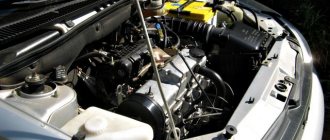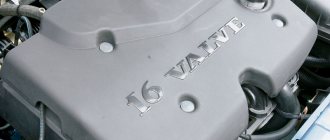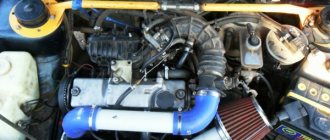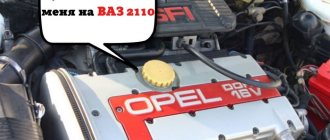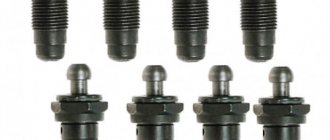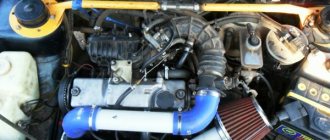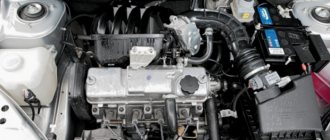The domestic “ten” is a fairly popular car at the moment, and it gained its popularity due to its low cost and maintainability. The VAZ 2110 is a car for all occasions; it has good reliability and excellent technical characteristics, because it is not without reason that many different engines were installed on it.
The VAZ 2110 was equipped with carburetor and injection engines with a volume of 1.5 liters to 1.6 liters. This Lada model even had a rotary engine with a power of up to 140 hp.
This article talks about the engines installed on the VAZ 2110, namely their technical characteristics, pros and cons.
Motor 2101 “Kopeyka”
It’s no secret that the first “Kopeyka” is a prototype of the Italian FIAT 124.
Accordingly, the first of the VAZ engines was initially only a modification of its predecessor, a kind of tuning of the VAZ engine.
The characteristics of VAZ engines have been changed:
- Thanks to the transfer of the camshaft from the lower to the upper part, an increase in the cylinder diameter by 3 mm, and a decrease in the piston stroke by 5.5 mm, the unit became more throttle response due to its transformation into a “short-stroke” one. The speed picked up faster, and throttle response began to be felt more strongly with sudden changes in the accelerator position.
- The only drawback of the engine at that time, which received the marking 2101, was the increase in noise.
- 4 years later, after the modification of “Kopeyka” 21011, a modernized VAZ engine of the same name appeared with markings identical to the model number. It began to differ from its recent ancestor in the following indicators: the VAZ engine displacement increased from 1200 to 1300 cm3, the cylinder diameter increased by another 3 mm, and the power increased by 3 “horses”. This VAZ engine was installed on both 01 series models and subsequent 2102 models.
- Carburetors for these engines were produced in 3 series until 1978, and later the Ozone 2105 appeared, which acquired an autonomous idle system, slightly changing the technical characteristics of the VAZ engine. These carburetors became much more practical, the car started easier in cold weather, and the quality of the fuel was less reflected in idling and sharp pressure on the accelerator.
Further tuning of the VAZ engine consisted of strengthening the transmission, which Italian engineers liked, and later they began to use Soviet modifications on their units.
Later, exports began to spread, and for the first time a rotary engine in a VAZ appeared on cars sent to neighboring countries.
This was the first successful experiment, but due to the difficulty of repairing such a unit and the virtual lack of spare parts, over time these types of motors became unpopular. Although analysts predicted a good future for units of this type, it was only necessary to properly establish the spare parts market.
Motor VAZ 2103
Since the late 70s, cars produced on special order, for example, for some police units, have had a completely new power unit, which has different technical characteristics, unlike other VAZ engines.
It was installed both on the later Kopeykas and on its successors - export 2102, 2103, 2107 and later on 2121, 21053.
These VAZ 2103 engines have become an absolute novelty (plural, but before and after everything is singular). Thanks to its dynamics, they allowed it to accelerate to 100 km/h in less than 17 seconds.
Such indicators became possible due to a number of changes:
- The volume increased to 1500 cm3;
- The piston stroke increased by 14 mm;
- maximum power became 77 hp. With. ;
- torque was determined for the first time. On this type of VAZ engine it became 104/3400.
The cylinder block is made of a special cast iron alloy, the cylinder head is made of aluminum. These rules were mandatory for all types of engines, and the fundamental difference was in the diameter of the cylinders. If for units 21011, 2105 and 2106 it was within 79 mm, then in 2103 it became 76 mm.
Another positive feature of this model is the ability to install crankshaft 21213, which has identical parameters, but improved technical characteristics of the VAZ engine.
In addition, the 2103 can be equipped with both classic and contactless ignition. Rebuilding the engine was not particularly difficult for specialists, and the availability of spare parts in terms of availability and pricing did not force the owner to search for places and means of purchase for a long time.
Motor VAZ 2106
The baton of the engine, which became a real breakthrough in the Soviet market, was taken over by the VAZ 2106 engine.
It became a natural modification of the 2103 in order to increase the technical characteristics of VAZ engines in the direction of power.
The engineers achieved it:
- increasing the working volume to 1600 cm3, using the cylinder diameter, which again became 79 mm.
- The pistons for this VAZ engine were used from 21011 and it, like the donor, had two repair sizes. These VAZ engines had no other fundamental differences from the 2103, since they were equipped in the same way as their older relatives, with an “Ozone” carburetor and an ignition distributor with the same vacuum regulator.
But the 2106 engine did not find much sympathy among the owners, just as rotary engines on VAZs were once exported, since the owners of 2103, 2121, 2107 tried to select the more reliable VAZ 2103 engine.
This was due to the lower viability of the 2106 and instability of operation when using lower quality fuel. The saddest outcome was burnout of the valves and the unit required major repairs in these cases much more often than 2103.
Motor VAZ 21083
Before considering the characteristics of VAZ engines of a completely new principle, it is worth paying attention to such transitional units as 2108, 2110 and 2111, since it was with them that the era of fuel injection by injector and the birth of front-wheel drive began.
Both of these engines are installed on models 2108, 21083, 2109, 21099, so it is currently very popular to replace an old carburetor engine with an injection engine, due to the many advantages of the latter.
What changed:
- The fundamental difference between the 21083 engine, like its predecessor 2108, was that it had to be transverse in placement due to front-wheel drive. The fundamentally new piston, which used a special micro-profile, retains lubricant much better than the early 2103, which was coated with tin.
- ICE 21083 is modified with a cylinder diameter of up to 82 mm, a working volume of up to 1500 cm3, and a maximum power of 65 hp. With. increases to 68, and torque from 95 to 100.5/3400.
- The timing drive of VAZ engines of the 8th family becomes belt driven, unlike the 2103, where there was still a chain. The quality of this change is certainly debatable, but every car enthusiast finds positive and negative sides in any type of timing drive.
- New features in the VAZ 2108 and 21083 engines include a new carburetor, which becomes much more economical than its predecessor, a completely different oil pump, driven by the crankshaft; a gasoline pump with outlet and inlet pipes on the same line, as well as a structurally different water pump.
Engine 1.6l 16kl
On VAZ 2114, 2113, 2115, in a limited series from the SuperAvto production, 16kl were installed. 1.6 liter engines with indexes 21124 from “Dvenashka” with a power of 89 hp. and from Priora with index 21126 with a power of 98 hp.
Engine 21124 1.6l 16kl:
- Power – 89hp
- Torque – 131 Nm at 3100 rpm. min.
- Acceleration to 100 km/h – 11.5 s.
Engine 21126 1.6l 16kl:
- Power – 98hp
- Torque – 145 Nm at 4000 (rpm).
- Acceleration to 100 km/h – 10.5 s.
Motor VAZ 2111
As mentioned above, the VAZ 2111 engine is the beginning of the era of distributed fuel injection. The appearance of cars of the “tenth family” allowed engineers to work in a qualitatively new direction, and in general, it was successful, completely changing the standard operating parameters of VAZ injection engines.
Motor 2111, like its successors 2112, 21114, 21124, 21118, are installed on car models 2108, 2109, 21099, 2110, 2111, 2112, 2114, 2115 in their various modifications, as well as on Lada Kalina. Many owners of old carburetor cars, without betraying their favorites, simply install a new injection unit in their cars, thereby extending their life by more than a dozen years.
What changed:
- Over a fifteen-year period, these units changed their volume from 1500 cm3 to 1800, and their power increased by 20 hp. With. And if the 2111 engine is a kind of modification of the 21083 and 2110, distinguished by additional mounting holes for the generator, an ignition module and a knock sensor, then, for example, the VAZ 21124 engine is a fundamentally different unit. Chip tuning of the VAZ engine originates from it.
- The only controversial point in the particularity of these VAZ engines is the increase in the number of valves from 8 to 16. And if you are wondering on which engines the valves bend when the timing belt breaks, then you need to remember only one modification of the engine: 2112, despite the fact that it one of the most common VAZ engines for tuning.
- In addition, the VAZ 2112 engine has completely different characteristics among VAZ engines and other typical operating parameters of VAZ injection engines. Unlike 2111, the power here has been increased to 93 hp. With. (2111 – 78), torque 127/3700 (115/3000), with a reduced volume from 1600 to 1500 cm3.
- Another camshaft appears here, as well as a different air supply system to the cylinders. This engine, naturally, has become more powerful, but the driver would rather prefer a calmer and more economical driving style due to the torque at low speeds.
- The difference between the later 21114 and 21124 is that the height of the cylinder block was increased by 2 mm, and the crankshaft stroke increased from 71 to 75.5. These technical characteristics determined the addition of volume to the VAZ engine up to 1600 cm3.
- Plus, the fuel system with the injector ramp has been slightly modified, the fuel return line has been eliminated, and a catalytic converter has been installed.
- The fundamentally new ignition system is now a four-terminal coil, and not an ignition module, as on the 2111. The quality of this ignition is certainly better, but some problems may appear during the plant in winter, but this is only out of habit.
Most often, when choosing a car, taking into account the technical characteristics, owners try to avoid this unit, but this is done only by those who are not very meticulous about caring for the engine, since troubles can be avoided by timely replacement of the belt, and the purchase of this part should be treated more responsibly .
When choosing a belt, you can only trust a trusted manufacturer, information about which can be found on the Internet or from friends, since you cannot trust salespeople in stores 100%. Frequent counterfeits of well-known companies cannot be ruled out, which leads to underestimation of a particular belt. Accordingly, at least within the time specified by the standard characteristics, the belt simply must be checked by the owner.
Which engine is better: 1.5 8kl or 1.6 8kl?
When choosing a car, people often wonder, which engine is better? In our case, everything is not so simple. A similar question may arise if we consider buying a car already in the shaggy year: 2006-2007. It was during this period that both 1.6l and 1.5l engines were installed on the VAZ 2113 2114 2115, the characteristics of which are outlined above.
In essence, the 1.5 and 1.6L 8cl engines are no different, except for volume, exhaust standards, fuel supply systems and a couple of sensors. Therefore, the main distinguishing point is the engine size. A difference of 0.1 liters gives much more torque from the bottom, a little more maximum power and, perhaps, even the same or even lower engine consumption than a 1.5 liter. The only negative is that it is noisier at idle.
Previously, in the years 2008-2012, people were not willing to take 1.6 engines because they were fragile, loud, etc. – in fact, the 1.6 engine is superior to the 1.5 liter engine in all respects, so we recommend it to you. But this applies to 8 cl motors that were installed serially. Next we will consider 16kl. motors.
Tuning
It is noteworthy that tuning a VAZ engine, as well as its repair, is possible for any owner who has at least a little knowledge of the technical characteristics of VAZ engines and has encountered repairs or overhauls of the engine.
But here the choice is between efficiency and power. Knowledge of which engines bend the valves is also important. The approaches to them are very complex.
The most common is tuning the VAZ engine, which increases the output parameters. For example, installing a new camshaft with an adjustable pulley, replacing connecting rods and pistons to increase displacement.
Well, in order for the power to be realized into the dynamic data of the car, the gearbox ratios are changed. This is the most budget-friendly VAZ engine tuning without any outside interference in the auxiliary units, despite the fact that this same tuning can be much more extensive.
It is worth remembering that any increase in power leads to additional fuel consumption and reduces the life of the unit; accordingly, it requires increased attention to maintenance and replacement of consumables. Therefore, the issue of tuning must be approached painstakingly and it is advisable that a person well versed in this take part in this.
What kind of oil should I pour into the engine?
Malso comes in both transmission and engine versions. Oils are also divided by viscosity class. A certain engine is designed for a certain viscosity. For example, some motors prefer synthetics, while others prefer semi-synthetics.
Which engine is better, 8 or 16 valve? Let's look at simple examples
And the 8-valve engine would no longer be produced, since it would simply become unnecessary and obsolete. However, 8 valves are installed even on well-known brands.
For example, 8-valve models are considered more durable and suitable for repairs, although the model is also available with 16. Similar engines are also found in Toyota products, especially in small cars, including Auris and Corolla E15/E18
. Accordingly, such engines cannot definitely be called obsolete and outdated. Again, for some it’s better when there’s more, and for whom it’s better when it’s easier and more repairable. After all, the more complex the design, the more its components can fail, and it will be less possible to repair it yourself.
